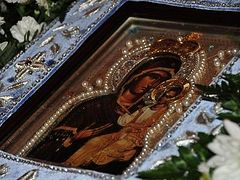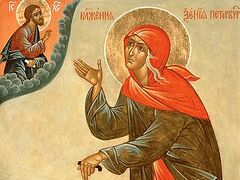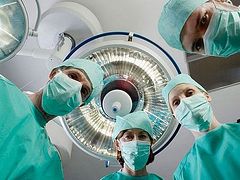Mila is a parishioner of St. John the Baptist Cathedral in Washington. She spent ten years in hospitals, undergoing fifty major operations and many other minor ones. Doctors told her frankly that she had one foot in the grave and that there was no chance of recovery. Mila has almost no intestines and she is put on a drip for several hours a day. Nevertheless, she not only rejoices in life, but actively helps the church as much as she is able: baking prosphora and cooking delicious lunches for parishioners. She connects her deliverance to a miracle: The Most Holy Theotokos and Blessed Xenia of St. Petersburg helped her.
A correspondent of Pravoslavie.ru met Mila in Washington and recorded her story.
From the wedding to the hospital
I grew up in a small Kyrgyz town, and after school I studied to be a paramedic-obstetrician. My friends knew about my cheery and joyous character, so they often invited me to MC their parties. It was a good living for a student. A few months before graduation, I was the MC at a wedding. After the meal, I got so sick that they called the ambulance. The hospital diagnosed me with intestinal obstruction, but as a medic, I knew that was wrong. How could it be intestinal obstruction when I had severe vomiting and an upset stomach? They didn’t even give me any barium sulfate, but you can’t see the digestive organs on an x-ray screen without it.
It was poisoning. But who would listen to me, a young girl? I found out about the surgery when they put me on the table and put an anesthesia mask on me. An incorrect diagnosis and not taking into account my adhesions (from an unsuccessful removal of my appendix in childhood) led to my intestines being torn. A few days after the operation, they tried to put me in an upright position. It was a terrible picture: The seams began to tear and I started to ooze from my stomach.
The medics did several procedures and gave me to my relatives saying, “Take her home. She doesn’t have long left.”
My parents decided not to give up and took me to Bishkek, the capital of Kyrgyzstan, where I underwent a long course of treatment and more surgeries. But it was all in vain: They cut me, they sewed me up, they sat me up, and everything was torn again. The specialists shrugged helplessly, not concealing that only a miracle could help me.
Like a guinea pig
 Matushka Maria Potapov visiting Mila in the hospital
Matushka Maria Potapov visiting Mila in the hospital
Apparently, my case was interesting, and they took me at the military hospital at the American base in Bishkek. Some Korean doctors worked with me there. I signed a document saying I was familiar with the stipulations. In particular, the agreement stated that the hospital was not responsible for the consequences and the medics had the right to conduct experiments and video record all the operations and therapeutic procedures. They really did whatever they wanted—up to and including doing surgery without anesthesia. Can you imagine the pain? They fastened me to the table and held my head in their hands. I endured so much there! They put me on my feet almost immediately after the operation and made me walk. Having taken a few uncertain steps, I fainted. They brought me to my senses, picked me up by my collar, as if I were a kitten instead of a person, and demanded that I keep walking.
I had no one to complain to: I had voluntarily signed the agreement. And it was impossible to escape because of my physical condition and because the hospital was on the territory of a military base, with a fence and security.
I couldn’t cry to my family either—no one was allowed to see me. I felt like everyone had abandoned me.
Then they said the medications were running out and there was no clear plan of treatment. Then, like a guinea pig, I was passed on to the American doctors of the same hospital, including one who was a parishioner of the Protestant church on the military base. He sympathized with me, looking for an opportunity to help. One day he asked if I wanted to go to the U.S. for treatment. Of course, I wouldn’t make it the whole way, so I went through Germany. The trip was difficult. I went to a German hospital for a month. Then I wound up at the Walter Reed military hospital in Bethesda, Maryland.
Again, I had one operation after another. Sometimes they didn’t even put me on the operation table; my stomach was always open, the skin there was almost rotten, and my internal organs were visible. I couldn’t turn over on my side or my back: All my insides would fall out. I couldn’t eat or drink on my own for two years; I forgot how to do it.
After some time, it became clear that they had to stop the operations: My body couldn’t take any new intrusions. They painfully put on new bandages every two hours. I was depressed and didn’t want to live. I was lying there, rotting alive. It wasn’t just about my bodily “fatigue,” but that the surgeons didn’t know what to do with me, and they gave up on me.
Only one doctor pitied me, was tuned into my condition, and agreed to take me on. True, she was a heart surgeon, but despite her different, non-gastrointestinal specialization, she promised to try to connect my intestines, so they’d be like with all “normal” people. The woman honestly warned me that “it might not get better, but it definitely won’t get worse.” I had no choice. Alas, her efforts proved to be unsuccessful.
Help from the Most Holy Theotokos
Here I’ll tell you about the first miracle that happened to me. When this compassionate doctor operated, a blood clot broke off from my leg and passed through my heart. No one knew where it would stop—if in the head, I would either turn into a vegetable or die. It was impossible to remove the clot at this stage. The only thing left to do was wait. I was put in an induced coma. It helped slow down the processes in my body, including making the clot move slower. Having heard about the clot, my friend went to St. John the Forerunner Cathedral, although he wasn’t religious. He knew the rector, Fr. Victor Potapov, and his wife, Matushka Maria, and asked them to pray for me. Fr. Victor and other priests and deacons started reading the Akathist to the Most Holy Theotokos before the myrrh-streaming Hawaiian Iveron Icon of the Mother of God. While in the coma, it was as if I saw the faithful in the church, watching and hearing how they were praying. Suddenly a large black cloud started rushing towards me. I was scared, and I shouted: “Most Holy Theotokos, help!” And I entreated those gathered in the church: “Pray, please! Pray for me again and again!” A few seconds later, a golden chariot appeared and rushed through this terrible cloud, and on this chariot was the Most Holy Theotokos, dressed as a queen; on her head—a beautiful golden crown. The Mother of God looked at me affectionately and silently held out her hand. I grabbed it…
Then I woke up and heard from the doctors: “Good news—the clot went to your lungs, not your head, and it broke up there.”
I could have taken it for a dream, but I told my friends in detail about who was standing where during the Akathist before the icon, how many people were in the church, how the light fell through the window, and other details. I told them everything as if I had been in the church myself then. Of course, it was a miracle: The Mother of God saved me, having mercy upon me.
In the mysterious doctor I recognized Blessed Xenia of St. Petersburg
After this operation, they decided to raise the level of my hormones and steroids. The doctors thought this approach would make my intestines grow. These medicines have side effects, but they gave them to me in such doses that it’s amazing that I survived.
A month after therapy, a middle-aged female doctor in a white coat came into my room. She said, in Russian, without any accent: “Hello! I’ve come to see how they’re treating you. I see what doses they’re giving you. You can’t inject that much. It’s like a human experiment, not treatment. Don’t worry, I’ll make changes to your treatment plan. I’ll remove these medications and no one will put them back.”
The unknown doctor went to the medical staff’s duty station and sat down at the computer. Nurses were talking and looking at medical forms all around her, but they didn’t seem to see my visitor. This new doctor did some work at the computer and left. It didn’t surprise me at the time, but then I thought about it.
It all seemed strange. The doctor spoke to me in Russian. She came alone, although in American hospitals, the attending doctor usually introduces a new specialist, explaining what area he worked in, what questions he was interested in. I thought maybe it was an intern. But she didn’t seem like that either—her age didn’t fit, as trainees are usually young. The feeling remained: Everything seemed alright, but somehow there were a lot of strange things in what happened. I have had a lot of experience—I’d been in the hospital for so many years, and communication with American doctors was different. I hadn’t met any Russian doctors in the military hospital either…
 Mila Over time, I forgot about this unusual encounter.
Mila Over time, I forgot about this unusual encounter.
And the other day, I “found out” who my kind visitor was. I spend a lot of time on YouTube—it’s my little world. Through it, I can travel, go to church, and learn new things. And not long ago, I was watching a program talking in detail about Orthodox icons. They showed an icon of Blessed Xenia of St. Petersburg up close. I paused the video and loudly called for my husband: “Come here, quick, look: That’s the face of the doctor who canceled my hormone therapy! This saint came to me in the hospital under the guise of a doctor!” I had never seen that exact icon of St. Xenia before that. I was so amazed that I wept and laughed.
Now I understood why no one noticed how this “strange” woman in a white coat walked around the hospital, why she had no badge, and how she bypassed the security points and worked unencumbered at the computer. Of course, it was a miracle.
After the visitation of the saint, I started to get better, and I felt lighter and better.
Yes, things still aren’t easy for me, but I’m alive, I rejoice in life, I pray, I bake prosphora, I go on pilgrimages—for example, to Holy Trinity Monastery in Jordanville, New York. I enjoy a lot of things. I’m learning to draw now, and I found recipes for making chocolate candies. I love to read. For example, the book Fr. Arseny made a strong impression on me. It helps me to understand: How can I be sad when people have gone through more difficult times and suffered so much?!





